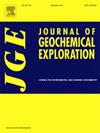MgCO3/MgO工业渣碱活化尾矿的化学稳定性及环境特性
IF 3.3
2区 地球科学
Q1 GEOCHEMISTRY & GEOPHYSICS
引用次数: 0
摘要
矿山尾矿通常与普通硅酸盐水泥(OPC)和水混合成膏体,用于巷道回填(MGBF)。尽管OPC仍然是最常用的选择,但由于以下几个限制,人们正在研究替代碱性试剂,如Mg(OH)2:成本高,生产过程中碳足迹大,长期耐用性有限,特别是因为它容易受到硫酸盐的侵蚀。本研究考察了MgCO3/MgO工业残留物的使用如何影响各种尾矿(mt)中碱活性膏体的环境行为,并考虑了不同试验的结果:ABA试验、UNE 12457-4的浸出试验和单轴抗压强度(UCS)试验。使用不同的MgCO3/MgO浓度和六种非常不同类型的MTs生成不同的膏体配方,这些MTs具有广泛的矿物学,化学和酸势特征。作为一个主要结论,所有碱活化膏体,与原来的mt相比,表现出非常重要的改善其环境行为,其标志是其产酸潜力的持续减少,其渗滤液的水质改善以及根据欧洲垃圾填埋场废物接收法规对惰性废物的新考虑。动态长期浸出实验和反应输运地球化学模型可以更好地理解这类矿渣在实际条件下和长期(几十年至几百年)的行为;本研究表明,ABA和UNE 12457-4试验的联合应用如何能够为碱活化矿膏提供可靠的初始环境表征。本文章由计算机程序翻译,如有差异,请以英文原文为准。
Chemical stability and environmental characterization of alkali-activated mine tailings generated using a MgCO3/MgO industrial residue
Mining tailings are commonly combined with ordinary Portland cement (OPC) and water to form a paste used for mine gallery backfilling (MGBF). Although OPC remains the most frequent choice, alternative alkaline reagents such as Mg(OH)2 are being investigated due to several limitations: its high cost, a significant carbon footprint associated with its production, and limited long-term durability, especially because of its vulnerability to sulfate attack. This study examines how the use of a MgCO3/MgO industrial residue affects the environmental behavior of alkali-activated pastes in a wide range of mine tailings (MTs), considering the results obtained from different tests: ABA test, leaching test according to UNE 12457-4 and uniaxial compressive strength (UCS) tests. Various paste formulations were generated using different MgCO3/MgO concentrations and six very different types of MTs spanning a wide range mineralogical, chemical and acid potential characteristic. As a main conclusion, all alkali-activated pastes, when compared with the original MTs, showed a very important improvement of their environmental behavior, marked by a consistent reduction of their acid generation potential, a water quality improvement of their leachates and their new consideration of inert wastes according to the European regulation for waste acceptance at landfills. While dynamic long-term leaching experiments and reactive transport geochemical models are advisable to better understand the behavior of these type of mine residues under real conditions and in the long term (decades to centuries); the present study shows how the combined application of ABA and UNE 12457-4 tests can offers a reliable initial environmental characterization of alkali-activated mine pastes.
求助全文
通过发布文献求助,成功后即可免费获取论文全文。
去求助
来源期刊

Journal of Geochemical Exploration
地学-地球化学与地球物理
CiteScore
7.40
自引率
7.70%
发文量
148
审稿时长
8.1 months
期刊介绍:
Journal of Geochemical Exploration is mostly dedicated to publication of original studies in exploration and environmental geochemistry and related topics.
Contributions considered of prevalent interest for the journal include researches based on the application of innovative methods to:
define the genesis and the evolution of mineral deposits including transfer of elements in large-scale mineralized areas.
analyze complex systems at the boundaries between bio-geochemistry, metal transport and mineral accumulation.
evaluate effects of historical mining activities on the surface environment.
trace pollutant sources and define their fate and transport models in the near-surface and surface environments involving solid, fluid and aerial matrices.
assess and quantify natural and technogenic radioactivity in the environment.
determine geochemical anomalies and set baseline reference values using compositional data analysis, multivariate statistics and geo-spatial analysis.
assess the impacts of anthropogenic contamination on ecosystems and human health at local and regional scale to prioritize and classify risks through deterministic and stochastic approaches.
Papers dedicated to the presentation of newly developed methods in analytical geochemistry to be applied in the field or in laboratory are also within the topics of interest for the journal.
 求助内容:
求助内容: 应助结果提醒方式:
应助结果提醒方式:


